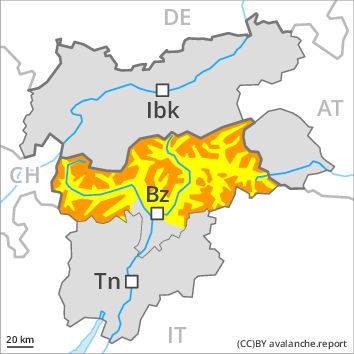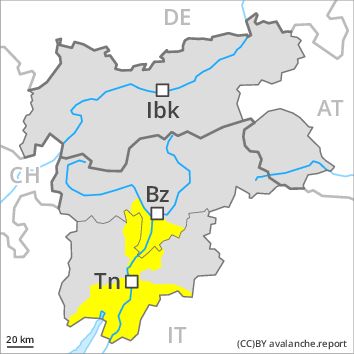Regions
Sexten Dolomites, Eastern Pfunderer Mountains, Durreck Range, Val Müstair Alps, Western Rieserferner Mountains, Langtaufers, Western Deferegger Alps, Schnals Ridge, Ortler Range, Southern Stubai Alps, Ulten Valley, Southern Zillertal Alps and High Tauern, Saldurn-Mastaun Ridge, Texel Mountains, Gröden Dolomites, Sarntal Alps, Prags Dolomites, Western Pfunderer Mountains

Danger level
Avalanche Problem
Wind-drifted snow above 2200m, N-NE-E-SE-S-SW-W-NW
Persistent weak layer above 2200m, N-NE-E-SE-S-SW-W-NW

The wind slabs are to be evaluated with care and prudence in particular in very steep terrain.
Fresh and somewhat older wind slabs must be evaluated with care and prudence in all aspects above approximately 2200 m. Avalanches can be released by a single winter sport participant and reach large size in isolated cases. The wind slabs are to be found in particular in gullies and bowls, and behind abrupt changes in the terrain. In isolated cases avalanches can be triggered in deep layers of the snowpack. The number and size of avalanche prone locations will increase with altitude. The current avalanche situation calls for careful route selection. In addition there is a danger of gliding avalanches.
Snowpack
dp 6: cold, loose snow and wind
In some cases the wind slabs have bonded poorly with each other and the old snowpack. Wind slabs are clearly recognisable to the trained eye. Transitions from a shallow to a deep snowpack where weaknesses exist in the old snowpack are especially precarious. Faceted weak layers exist in the old snowpack, in particular on steep, rather lightly snow-covered east, south and west facing slopes as well as adjacent to ridgelines above approximately 2200 m.
Tendency
Slight decrease in danger of dry avalanches.
